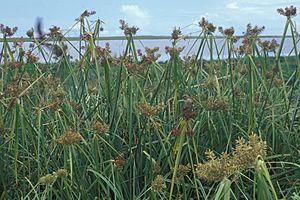Coastal flatsedge facts for kids
Quick facts for kids Coastal flatsedge |
|
|---|---|
 |
|
| Cyperus pennatiformis subsp. bryanii | |
| Scientific classification | |
| Genus: |
Cyperus
|
| Species: |
pennatiformis
|
| Synonyms | |
|
Mariscus pennatiformis |
|
The Coastal flatsedge (scientific name: Cyperus pennatiformis) is a very rare type of sedge plant. It used to be called Mariscus pennatiformis. This special plant only grows in Hawaii. You can find it on the islands of Maui, Kauai, and Laysan. Because it is so rare, the United States government lists it as an endangered species. This means it needs protection to survive.
Contents
What is Coastal Flatsedge?
This sedge can grow quite tall, from about 40 centimeters (1.3 feet) to 1.2 meters (almost 4 feet). Its leaves are strong and leathery. They can be as long as the stem or even longer.
How Does it Look?
At the top of the stem, the plant has a flower cluster. This cluster looks like an umbrella and can be up to 15 centimeters (6 inches) long and 25 centimeters (10 inches) wide. It holds up to 18 spikes. Each spike is made of several small, yellowish or grayish parts called spikelets. Each spikelet can have up to 25 tiny flowers.
Where Does it Live?
Today, you can find the Coastal flatsedge on Maui, Kauai, and Laysan islands. Sadly, it has recently disappeared from Oahu and the island of Hawaii.
How Many Plants Are Left?
Recent checks found only about 30 individual plants on Maui. There are four groups of these plants on Kauai. These plants belong to a specific type called subspecies pennatiformis.
On Laysan, the plants are a different type called subspecies bryanii. This one is known as the Laysan sedge or Bryan's sedge. In 2008, a total of 488 Laysan sedge plants were counted. Even though it is rare, the Laysan sedge seems to be growing and making new plants successfully.
What Kind of Home Does it Like?
The Coastal flatsedge grows in different places depending on the island.
- On Maui, it lives on cliffs by the sea. Ocean spray often washes over these plants. Their home is a coastal forest with many hala trees.
- On Kauai, you can find it in wet, forested canyons.
- On Laysan, the Laysan sedge (ssp. bryanii) grows in wetlands and sandy dunes.
Why is it Endangered?
This plant faces many dangers that threaten its survival.
Main Threats
- Habitat Loss: Its natural home is being destroyed or damaged.
- Animals: Wild animals like pigs and goats roam freely. They eat or trample the plants, causing a lot of damage.
- Invasive Plants: Non-native plants are a big problem. These plants come from other places and grow quickly. They take over the space and resources that the native sedge needs.
Problem Plants
Some of the worst invasive plants include:
- Shoebutton (Ardisia elliptica)
- Lantana (Lantana camara)
- Yellow foxtail (Setaria parviflora)
- Pride of India (Melia azedarach)
Past Problems
On Laysan, many sedge plants and other native plants were severely harmed by rabbits that were brought to the island. The seeds of the sedge are also a food source for the Laysan finch bird (Telespiza cantans).

